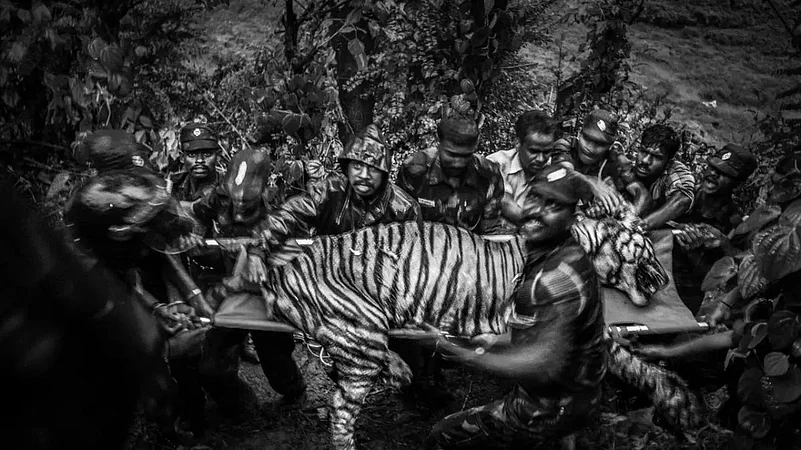As India marks 50 years of Project Tiger – a bold initiative launched to recover the magnificent Royal Bengal Tiger, resulting in their population now flourishing across the nation, it is perhaps the perfect time for the initiative to widen its horizon. Instead of an obsessive focus on increasing tiger numbers, it urgently needs to shift its lens to integrating the local communities who have been alienated, despite having lived with tigers for ages.
India, where over a billion people reside in some of the world's densest populations, aspires to give its people a modern life, fueling rapid urbanisation that is driving significant land-use changes. Coexistence between humans and the environment, therefore, appears to be a distant utopia, even more so when we consider coexistence with large wild predators like tigers, who may (and do) constitute a potential threat to human lives and livelihoods wherever they co-occur with humans.
Counterintuitively, however, and much like its culturally diverse people living in relative harmony, human-wildlife coexistence also abounds in this part of the world. Even with large and formidable species like elephants, tigers, and rhinos, and the serious negative impacts they potentially entail, the people of this country have remained relatively tolerant. It is intriguing and admirable at once, that despite its heavy human densities it still harbours nearly 60 per cent of the global Asian elephant population, 75 per cent of the global tiger population, besides a plethora of unique endemic species and natural ecosystems.
But this is today fast changing, with a growing widespread resentment for sharing space with wildlife species, especially the ‘beasts of lore’ like the tiger. Figures and media reports clearly portray the heightened public pressure on governments to remove any large wild animal from anywhere close to human dwellings, even when that is right beside protected areas. With even a stray sighting of a tiger, people invariably demand action from the forest department to either shift or 'sort' the animal and sometimes don't shy from taking matters into their own hands - often with devastating results such as the retaliatory killing of tigers.
Recovering tigers in the land of tigers
Unlike the majority of other large mammals in India's wilderness, the tiger has been rather fortunate. As the national animal of the country, the government gave it unmatched conservation attention. In 1973, Project Tiger was started with the sole purpose of saving the species from extinction from the country's landmass.
Having been relentlessly persecuted for over 200 years as a prized sport by the colonial regimen and the country's royal elites, India, with an estimated 40,000 tigers at the turn of the century (estimated from hunting records), harboured just about 1800 tigers by 1827 (through India’s first concerted estimation exercise). Despite this revelation, hunting for the sport still carried on until it was officially banned in 1972.
Project Tiger rolled on the need of the hour: ensuring the cessation of tiger hunting for sport and its poaching for trading its body parts to international markets, and also securing its habitat so its population could recuperate steadily. Recover, it did, in the numerous inviolate spaces project tiger created called Tiger Reserves. After an abysmally low estimate of 1400 individuals at the beginning of the 21st century, India today boasts estimated 3000 tigers thriving in 53 tiger reserves in the country.
Cracks in the Fortress Conservation Model
However, unrealised early on, and largely disregarded later, despite suggestions from experts, project tiger went on securing spaces for tigers at the cost of exclusion of local communities through poorly planned relocation programmes, and heavily policed enforcement of the new laws of the land. A direct consequence of this was the severing and alienation of local communities from their lands (in most places where they had lived for generations), and all efforts to conserve it for its wild denizens, including the tiger.
Such a disconnect between people and conservation initiatives is recognised as severely detrimental for the successful conservation of any species. Over the last 50 years of implementation of Project Tiger, this has only been exacerbated, fuelled further by aspirations for modern development, leading to the heightened antagonism that people widely express towards tigers and agencies trying to conserve them.
An animal once revered by local communities turned into a foe whose presence meant losing your land and home, one’s livelihood, or even a loved one. This has also had spillover effects on other wildlife species such as elephants, leopards, and bears. It is no wonder therefore that local communities increasingly and widely today consider wildlife (and their habitats) to be government property and not something in its own right to exist, or for the wider public good.
A billion-strong human population with a deeply embedded ethos of ‘live and let live’, is today hastily shifting form – into one which is increasingly intolerant towards wildlife, especially ‘potentially dangerous beasts’ like tigers. This is deeply disconcerting for conservation, especially for large charismatic mammals that India so proudly harbours the largest populations of. It is imperative that this attitude is nipped early and turned around into one, where people truly share the pride in tigers (and other wildlife) and choose to live with them in coexistence, proactively managing negative interactions that may occur from time to time.
Having effectively now doubled the tiger population since 2010, it is perhaps an opportune time for India to reinvent Project Tiger into a ‘People for Tigers’ initiative, with local communities integral to its efforts, and its main beneficiary, if we are to sustain our pride in harboring the majority of the world population of this charismatic big cat.
People Turning Against Tigers
To ensure that the current tiger numbers thrive sustainably, it is crucial that conflicts with tigers are successfully managed outside tiger reserves. Valmiki tiger reserve is a glaring example in this regard. An erstwhile run-down tiger reserve in the eastern state of Bihar which remained devoid of tigers for over two decades managed to recover its tiger population after copious amounts of conservation work by various organizations and the forest department.
What went amiss however were efforts to take people into their stride towards bringing tigers back. Now, with tigers only beginning to bounce back, the park managers recently experienced immense public and political pressures to remove one individual that had purportedly killed several people. While this may be seen as a one-off incident, it is apparent that people were not ready to bear the risks of such negative interactions or manage them to minimize adversities.
Meanwhile, negative interactions between people and tigers here continue to escalate. Similar case studies abound from other parts of India - be it the killing of the famous tigress Avni in Maharashtra due to immense public pressure, the violent public lynching of a tigress in Pilibhit in Uttar Pradesh, the retaliatory killing of a male tiger hastily reintroduced into Satkosia tiger reserve in Odisha, or the numerous cases of poisoning and electrocution across the tiger’s distribution range in India, witnessed over the last decade or so.
Incessant persecution of tigers outside the park not only leads to significant declines in the source population in the core area but also lays the foundation for more widespread persecution by local communities using covert means.
Turning government's tiger into people’s tiger
Successful management of human-tiger conflicts can be achieved more efficiently and in more cost-effective ways if the local communities are taken on board and are integral partners in all initiatives concerning conflict mitigation and management, as well as other conservation aspects. It is also important that they see clear benefits to their lives and livelihoods as a result of conservation efforts for tigers.
A lot has been done on this latter front in recent years by governments and conservation organizations alike, but most unfortunately have followed a top-down approach, often providing supplemental or alternative livelihood options or alternative practices, without paying much heed to culturally ingrained practices and beliefs.
Co-planning and community-driven implementation must be integral to any lifestyle or livelihood betterment efforts that are carried out around tiger reserves, and long-term support to hand-hold people through transitions is also crucial. All of this, however, must begin first with a unanimous acceptance of the impending issue at hand and the gravity of the risks it entails.
It then is imperative to drive a complete paradigm shift in the approach of the forest department, especially the ground staff. This can be achieved if senior forest officials are encouraged to understand the need for stakeholder engagement and the various processes that entail doing so successfully.
Today, luckily there are numerous examples scattered across India, be it Maharashtra, Uttarakhand, Madhya Pradesh, Uttar Pradesh, or West Bengal, where the forest department and different NGOs and organizations have been working exemplarily with local communities, making great efforts to understand their problems and trying to resolve them in an inclusive and participatory manner.
Albeit at relatively small scales, these ‘bright spots’ have been witnessing great success compared to initiatives reliant on heavy policing and imposing restrictions. These efforts need to be appreciated, documented, highlighted, and replicated at larger scales, and also perhaps incorporated into the training curricula for the young Indian Forest Services (IFS) recruits and even for state forest department recruits, in order to embed the need for community integration into the management system. It is not enough to be simply cognizant of the need for community integration, it is of paramount importance to know its processes and nuances.
India is also witnessing large-scale destruction of its crucial wildlife corridors connecting tiger reserves, which are extensively used by tigers to move between protected areas, especially to establish new territories, which plays a key role in maintaining the genetic integrity of the populations within tiger reserves.
A huge effort is needed to safeguard these lands, and this must be done following novel approaches that do not lean on policing and excluding communities from their lands. Perhaps developing these community-owned lands as models of collaborative governance for conservation is something that needs to be urgently tested out instead.
A key role here is to be played by the forest department, to change the ‘fear of the uniform-clad officials’ prevalent in the minds of local communities, which only fuels rebellion. An inclusive and participatory approach by building confidence and trust amongst the local community may bear better fruit instead, in terms of long-lasting positive impacts on habitat conservation. Studies by scientists and anthropologists are also increasingly reinforcing our understanding that using traditional knowledge systems of local communities and integrating them into management initiatives is crucial for the successful conservation of wildlife spaces.
As a forest officer from central India exemplified to the authors - “The local farmers keep warning him and other forest guards to ensure that the ‘forest department’s tigers’ don't come into their farmlands” - that this is clearly today the biggest problem that plagues tiger conservation in India.
The Project Tiger therefore, starting from this year and for the next 50 years must build its approach and methods in such a manner that it succeeds to ensure that the tiger and its habitat start belonging to the people and not ‘just to the government’. Only when the people, especially those living around them have a feeling of ownership towards these big cats, can Project Tiger claim that its efforts to protect the national animal of India have truly been a success.
(The authors are members of IUCN- Species Survival Commission’s, Human Wildlife Conflict & Coexistence Specialist Group)





















